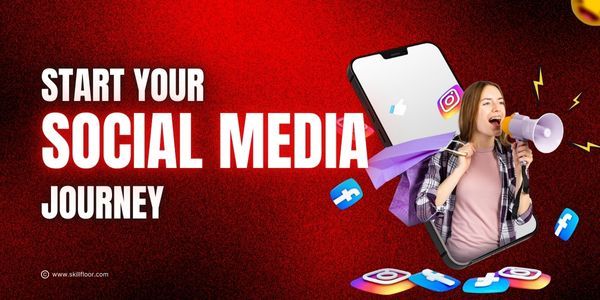Fundamentals of Social Media Marketing
Learn the fundamentals of social media marketing to create effective strategies, engage your audience, and drive results for your business.

Social media has the potential to revolutionize business. By establishing a strong online presence, I have witnessed small businesses increase revenue and draw in new clients. Seeing a shop owner's joy as her fan base and revenue increased demonstrated the incredible power of social media!
Social media marketing is about connecting, not just publishing. Providing a variety of material, such as client testimonials, lessons, or behind-the-scenes photos, helps strengthen relationships with followers. Facebook advertisements and Instagram Stories are excellent ways to connect with the individuals who will be most interested in your company.
Building trust and credibility in today's online environment is crucial because of Digital Marketing and the Fundamentals of Social Media Marketing. Companies that post worthwhile, interesting material and genuinely communicate with their audience establish themselves as respected authorities in their field. Frequent, well-considered posts foster enduring relationships and client loyalty in addition to increasing exposure.
What is Social Media Marketing?
Using social media sites like Facebook, Instagram, and Twitter to advertise your company is known as social media marketing. It assists companies in establishing a connection with their audience, disseminating interesting material, and cultivating a devoted following, all of which frequently increase client confidence and revenue.
Social media marketing transforms online spaces into efficient tools for growth by publishing original content, replying to followers, and running targeted advertisements. It helps brands maintain relationships, keep in touch, and leave a lasting impression.
There is Two Main Ways of Social Media Marketing:
Organic Social Media and Paid Social Media
1. Organic Social Media: This is all about building connections naturally. To gradually increase your audience without spending money on advertising, entails sharing updates, engaging with followers, and publishing material on a regular basis. Organic social media enables companies to interact more personally with their fans and create genuine connections.
2. Paid Social Media: Here, advertisements are used to swiftly reach a larger or more specific audience. Paid social media allows companies to target particular groups, promote particular postings, and increase exposure beyond their natural reach. Promoting sales, exclusive deals, or quickly contacting new potential clients may all be accomplished using paid social media.
Types of Social Media Marketing
1. Content Marketing
Sharing insightful blogs, articles, videos, and infographics with your audience may help you develop a devoted following over time by educating, inspiring, or amusing them.
Collaborating with well-known influencers to market your business. Their support enables you to swiftly establish credibility and connect with new audiences.
3. Social Media Advertising
Running paid ads to target particular regions, hobbies, or demographics on social media sites like Facebook, Instagram, or LinkedIn in an effort to increase traffic or revenue.
4. Video Marketing
Utilize social media sites like YouTube, TikTok, and Instagram Reels to post films that visually represent your goods, tell tales, or offer helpful tips.
5. User-Generated Content (UGC)
Encouraging followers to provide brand-related information of their own, such as images or reviews, so you may share it. UGC fosters trust and genuineness.
6. Social Media Contests and Giveaways
By giving away rewards for likes, shares, or tagging friends, you may engage followers, expand your audience, and generate buzz about your company.
Benefits of Social Media Marketing
-
Increases Brand Awareness: Social media marketing increases the visibility of your brand. Sharing information on a regular basis expands your audience and helps people recognize your company.
-
Builds Customer Loyalty: Businesses may interact directly with their followers, reply to comments, and establish relationships through social media marketing, which helps convert infrequent visitors into devoted, repeat clients.
-
Generates Leads and Sales: Businesses may use social media marketing to target particular audiences and promote items to those who are more likely to be interested, which can increase sales and conversions.
-
Cost-Effective Advertising: Social media marketing is a cost-effective way to reach targeted audiences. Launching a social media marketing campaign lets businesses advertise effectively, making it ideal for brands aiming for impactful results on a budget.
-
Provides Customer Insights: Businesses may enhance their marketing strategies and provide content that better fits the interests of their audience by using social media marketing to obtain insights into client preferences, habits, and demographics.
-
Enhances Brand Authority: Through social media marketing, companies establish themselves as leaders in their sector by disseminating useful information. Establishing brand authority and fostering trust are achieved via regular interaction and exchange of beneficial content.
Why Social Media Matters for Marketing
Social media helps companies of all sizes interact with consumers and create enduring relationships, which propels growth. The Fundamentals of Social Media Marketing are a crucial component of any modern marketing plan because they enable organizations to provide useful information, connect honestly, and improve their reputation.
Building credibility and trust on social media requires a significant presence, according to marketing experts. Before making a purchase, around 80% of consumers do brand research online. Through the acquisition of the Fundamentals of Social Media Marketing, companies may establish a meaningful connection with their target audience and establish themselves as reliable authorities in their field.
Social media allows companies to display their genuine side, which today's consumers really value. Businesses may gain customers' trust and loyalty by communicating authentically—by responding, sharing anecdotes, and responding to criticism. Brands may cultivate these connections and establish a solid reputation with their target audience by mastering the Fundamentals of Social Media Marketing.
Social Media Marketing can overcome
-
Choosing the Right Platform: Every platform has its personality. TikTok is focused on short videos, Instagram is all about visuals, and LinkedIn is more formal. Deciding which is ideal for your brand might be difficult.
-
Content Overload: Honestly, social media is overcrowded! People skim through posts, reels, and videos rapidly, and it's simple to get lost in the deluge. Time and ingenuity are needed to create memorable content.
-
Constant Changes: Social media is always evolving. Trends come and go, algorithms shift, and new features appear. You could feel like you're constantly attempting to catch up!
-
Measuring Success: Social media analytics may be confusing. It takes effort and knowledge to identify the data that matters—likes, shares, clicks, or follower growth—and understand it for development.
-
Keeping Up with Competitors: Social media is used by many businesses, which gives it a competitive air. It may be difficult to stay ahead of the competition and be distinctive, particularly when trends change frequently.A Certified Social Media Marketing Professional can help streamline and interpret this data effectively.
-
Balancing Frequency and Quality: Consistently posting is essential, but producing high-quality material on a daily basis might seem overwhelming. For many, striking the correct balance without burning out is difficult.
6 Key Fundamentals of Social Media Marketing
1. Set Clear Goals
Identifying your goals is the first stage in any marketing plan. You can stay focused and get direction by setting goals. Do you want to establish a devoted following, boost revenue, or raise brand awareness? Whatever your objective, make a note of it and refer to it when you organize your content.
For example:
-
Brand Awareness: Regularly provide interesting content to maintain brand awareness. People will remember you more the more they see you.
-
Increase Sales: Provide product evaluations, demos, and special offers to demonstrate the worth of your products and encourage followers to make a purchase.
-
Build a community: Engage in discussion, reply to comments, and engage with followers. As a result, you develop a devoted following that is associated with your brand.
2. Know Your Audience
To succeed, you must understand your audience. You can provide material that appeals to them when you are aware of their tastes and routines. You can create posts that genuinely connect by mastering the Fundamentals of Social Media Marketing.
Tip: Make a basic profile of your audience first. Consider their geography, hobbies, age, and the issues your product helps them with. This will assist direct your content and ensure that the appropriate audience is being reached.
3. Choose the Right Platforms
Remember that each platform has its own audience and style, so don't feel pressured to be present everywhere. Decide which one or two best suit your audience and objectives. Below is a brief guide:
-
Instagram: Great for providing visual content, particularly for lifestyle companies. Younger audiences like it, which makes it ideal for pieces that are imaginative and visually appealing.
-
Facebook: Its wide audience makes it perfect for creating communities and disseminating lengthier, more in-depth pieces. It's an adaptable platform for reaching a range of audiences.
-
LinkedIn: Ideal for networking between businesses. Excellent for professionals seeking a more formal, career-focused setting in which to network, exchange knowledge, and cultivate industry ties.

4. Plan Your Content
Making a plan in advance is a wise strategy to maintain organization and lower stress. Establishing a content schedule, which is essential to the Fundamentals of Social Media Marketing and Content Marketing, promotes consistency, which in turn increases the number of followers.
-
Content Types: Try experimenting with different post formats, such as images, videos, tales, and live broadcasts, to keep your audience interested and give your content some variation.
-
Content Mix: To keep things interesting, mix pieces that are educational, entertaining, and promotional. This blend displays many facets of your brand and keeps the audience interested.
-
Frequency: The secret is consistency! While posting three times a week isn't necessary, it may help you establish a consistent presence and interact with followers on a regular basis.
5. Engage with Your Audience
Social media is reciprocal. Your followers desire a sense of connection with you. Answer inquiries, provide comments, and express gratitude to your fans. Interacting with your audience increases credibility and humanizes your brand.
-
Reply to Comments: Show your followers you're paying attention by answering their questions, comments, and praise. Direct communication demonstrates your genuine concern and helps to establish confidence.
-
Ask Questions: You may promote engagement by asking questions in your captions. This increases interaction on your posts, starts a dialogue, and makes followers feel connected.
-
Share User-Generated Content: Repost client testimonials of your merchandise (with consent) to express gratitude. The communal sense of your brand is strengthened and authentic experiences are highlighted.
6. Track Your Performance
It's time to assess your performance after you've been blogging for some time. The majority of social media networks offer analytics that provide you with important information, such as the number of people who viewed and interacted with your post and what is most effective.
-
Key Metrics: Monitor follower growth, impressions, reach, and engagement rate. You may better assess your social media influence by looking at these analytics, which reveal what appeals to your audience.
-
Adjust and Improve: After observing which postings do well, create information that is comparable. Try a different strategy if something doesn't work to keep your audience interested.
-
Experiment with Timing: Experiment with publishing timings to determine the peak hours of your readership. Increasing exposure and engagement may be achieved by posting while followers are online.
The Future of Social Media Marketing
Social media is always evolving, so businesses must be adaptable. With the aid of emerging technologies like augmented reality, brands can create more engaging experiences. By understanding the Fundamentals of Social Media Marketing, businesses can use these technologies successfully and interact with customers in ways that keep them current and innovative.
For today's companies, social media is crucial, and experts point to influencer collaborations and short-form videos as major trends. In a cutthroat digital environment, understanding the Fundamentals of social media marketing enables businesses to establish trust via sincere, open communication, creating real connections that inspire enduring loyalty.
Nowadays, social media marketing is essential for every company hoping to succeed in the digital sphere. Businesses may successfully engage with their audience, establish credibility, and expand their impact by grasping the Fundamentals of Social Media Marketing. This method offers the necessary resources for producing interesting material, communicating in an authentic way, and being flexible in the face of change. Businesses may build lasting connections and differentiate themselves in a crowded market by adopting the Fundamentals of Social Media Marketing and establishing themselves as reliable, pertinent voices that consumers eagerly interact with.




























































